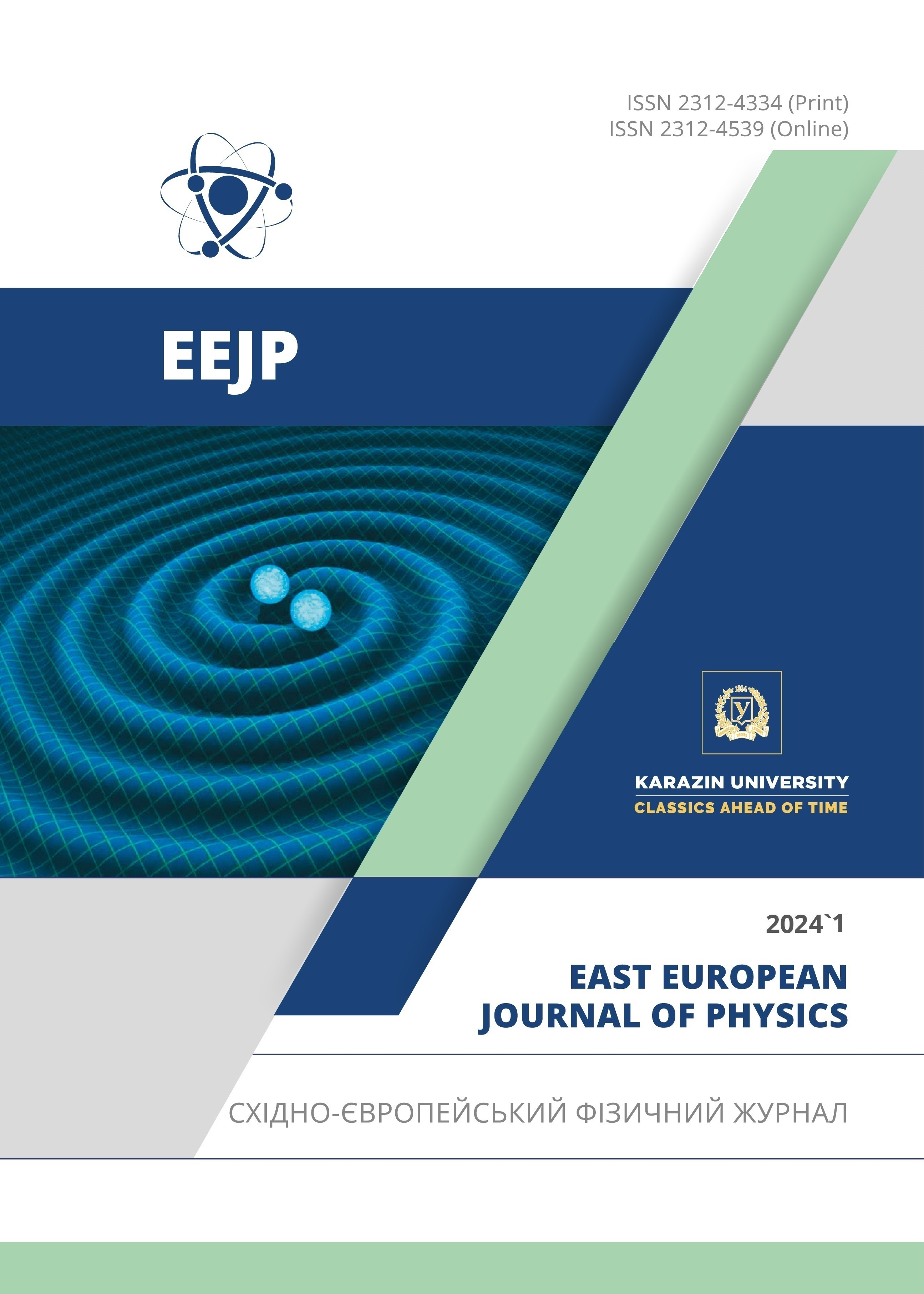Розробка нанопористих сенсоров ємнісного типу на основі ААО для аналізу наявності іонів важких металів (миш'яку)
Анотація
У цій роботі повідомляється про еволюцію датчика ємнісного типу на основі нанопористого анодного оксиду алюмінію (AAO), виготовленого за допомогою двоетапного процесу анодування з використанням недорогої індивідуальної установки, розробленої власними силами. Конденсатори з паралельними пластинами були виготовлені з використанням алюмінію (Al) як базового електрода та золота як верхнього електрода, де пористий AAO використовувався як діелектричний матеріал. Це продемонструвало чітку залежність значень ємності підготовлених різних сенсорів від товщини діелектричного матеріалу. Розроблені датчики були протестовані на виявлення іонів миш’яку (As). При збільшенні концентрації іона As у водних розчинах спостерігалося збільшення ємності. Наявність іонів As було підтверджено за допомогою картографування EDS (енергодисперсійна рентгенівська спектроскопія), виконаного в FESEM. Цю зміну ємності можна пояснити зміною діелектричної проникності активного матеріалу з включенням іонів металу.
Завантаження
Посилання
M.A. Kashi, and A. Ramazani, “The effect of Temperature and Concentration on the Self-Organized Pore Formation in Anodic Alumina,” J. Phys. D: Appl. Phys. 38, 2396 (2005).https://doi.org/10.1088/0022-3727/38/14/015
H. Masuda, F. Matsumoto, and, K. Nishio, “Fabrication of Functional Devices Based on Highly Ordered Anodic Porous Alumina,” Electrochemistry, 72, 389 (2004).https://doi.org/10.5796/electrochemistry.72.389
M. Iwai, T. Kikuchi, andR.O. Suzuki, “Self-Ordered Nanospike Porous Alumina Fabricated under a New Regime by an Anodizing Process in Alkaline Media,” Sci. Rep.11, 7240 (2021).https://doi.org/10.1038/s41598-021-86696-z
T. Islam, A.T. Nimal, U. Mittal,and M.U. Sharma, “A Micro Interdigitated Thin Film Metal Oxide Capacitive Sensor for Measuring Moisture in the Range of 175-625 Ppm,” Sens. Actuators B Chem. 221, 357 (2015).https://doi.org/10.1016/j.snb.2015.06.101
J.O. Carneiro, A. Ribeiro, F. Miranda, I.R. Segundo, S. Landi, V. Teixeira, and M.F.M. Costa, “Development of Capacitive-Type Sensors by Electrochemical Anodization: Humidity and Touch Sensing Applications,” Sensors,21, 7317 (2021).https://doi.org/10.3390/s21217317
M.A. Kashi, A. Ramazani, H. Abbasian,and A. Khayyatian, “Capacitive Humidity Sensors Based on Large Diameter Porous Alumina Prepared by High Current Anodization,” Sens. Actuators A, Phys. 174, 69 (2012).https://doi.org/10.1016/j.sna.2011.11.033
C.K. Chung, C.A. Ku, andZ.E. Wu, “A High-and- Rapid- Response Capacitive Humidity Sensor of Nanoporous Anodic Alumina by One- step Anodizing Commercial 1050 Aluminum Alloy and Its Enhancement Mechanism,” Sens. Actuators B, Chem. 343, 130156 (2021).https://doi.org/10.1016/j.snb.2021.130156
M.A. Mir, M.A. Shah, and P.A. Ganai, “Nanoporous Anodic Alumina (NAA) Prepared in Different Electrolytes with Different Pore Sizes for Humidity Sensing,” J. Solid State Electrochem. 24, 1679 (2020).https://doi.org/10.1007/s10008-020-04683-2
S.W. Chen, O.K. Khor, M.W. Liao, andC.K. Chung, “Sensitivity Evolution and Enhancement Mechanism of Porous Anodic Aluminum Oxide Humidity Sensor Using Magnetic Field,” Sens. Actuators B, Chem. 199, 384 (2014).https://doi.org/10.1016/j.snb.2014.03.057
C.K. Chung, O.K. Khor, C.J. Syu, andS.W. Chen, “Effect of Oxalic acid Concentration on the Magnetically Enhanced Capacitance and Resistance of AAO Humidity Sensor,” Sens. Actuators B, Chem. 210, 69 (2015).https://doi.org/10.1016/j.snb.2014.12.096
J. Wu, M. Cao, D. Tong, Z. Finkelstein, andE.M.V. Hoek, “Acritical review of point-of-use drinking water treatment in the United States,” Npj Clean Water.4, 40 (2021).https://doi.org/10.1038/s41545-021-00128-z
L. Weerasundara, Y.-S. Ok, andJ. Bundschuh, “Selective removal of arsenic in water: A critical review,” Environ. Pollut. 268, 115668 (2021).https://doi.org/10.1016/j.envpol.2020.115668
Md. G. Uddin, S. Nash, andA.I. Olbert, “A review of water quality index models and their use for assessing surface water quality,” Ecol.Indicat. 122, 107218 (2021).https://doi.org/10.1016/j.ecolind.2020.107218
L. Zheng, Z. Zhou, M. Rao, and Z. Sun, “Assessment of heavy metals and arsenic pollution in surface sediments from rivers around a uranium mining area in East China,” Environ Geochem Health,42, 1401 (2020).https://doi.org/10.1007/s10653-019-00428-x
H. Ahmad, A.R.A. Abdulwahab, B.H. Koo, and R.A. Khan, “Selective Extraction of Trace Arsenite Ions Using a Highly Porous Aluminum Oxide Membrane with Ordered Nanopores,” ACS Omega,7, 3044 (2022).https://doi.org/10.1021/acsomega.1c06133
A.P. Li, F. Müller, A. Birner, K. Nielsch, andU. Gösele, “Hexagonal Pore Arrays with a 50-420 nm Interpore Distance Formed by Self-Organization in Anodic Alumina,” J. Appl. Phys.84, 6023 (1998).https://doi.org/10.1063/1.368911
Авторське право (c) 2024 Трішна Моні Дас, Девабрата Сармах, Санкар Моні Борах, Сунандан Баруах

Цю роботу ліцензовано за Міжнародня ліцензія Creative Commons Attribution 4.0.
Автори, які публікуються у цьому журналі, погоджуються з наступними умовами:
- Автори залишають за собою право на авторство своєї роботи та передають журналу право першої публікації цієї роботи на умовах ліцензії Creative Commons Attribution License, котра дозволяє іншим особам вільно розповсюджувати опубліковану роботу з обов'язковим посиланням на авторів оригінальної роботи та першу публікацію роботи у цьому журналі.
- Автори мають право укладати самостійні додаткові угоди щодо неексклюзивного розповсюдження роботи у тому вигляді, в якому вона була опублікована цим журналом (наприклад, розміщувати роботу в електронному сховищі установи або публікувати у складі монографії), за умови збереження посилання на першу публікацію роботи у цьому журналі.
- Політика журналу дозволяє і заохочує розміщення авторами в мережі Інтернет (наприклад, у сховищах установ або на особистих веб-сайтах) рукопису роботи, як до подання цього рукопису до редакції, так і під час його редакційного опрацювання, оскільки це сприяє виникненню продуктивної наукової дискусії та позитивно позначається на оперативності та динаміці цитування опублікованої роботи (див. The Effect of Open Access).








